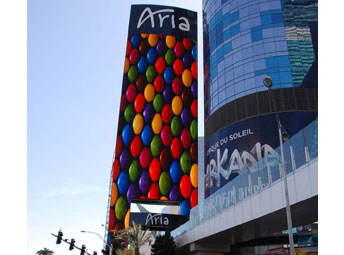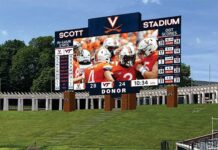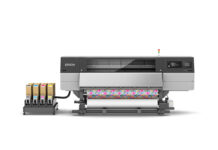 They say what happens in Vegas stays in Vegas, but the reputation of the double-sided, convex pylon sign outside of the Las Vegas CityCenter has extended beyond the city limits to receive national attention. But at a towering 260 feet tall and 65 feet wide, the Aria sign’s intention was never to blend in at all. In fact, it was to draw more attention to the new CityCenter and its attractions.
They say what happens in Vegas stays in Vegas, but the reputation of the double-sided, convex pylon sign outside of the Las Vegas CityCenter has extended beyond the city limits to receive national attention. But at a towering 260 feet tall and 65 feet wide, the Aria sign’s intention was never to blend in at all. In fact, it was to draw more attention to the new CityCenter and its attractions.
“Their primary focus on the development was literally to be the city center and there wasn’t a lot of discussion about having to put up a sign in front of the place. I think the focus was on the architecture being the sign,” says Rick Juleen, managing director of Sales at YESCO, which created the sign. “It wasn’t until they were open for about 18-24 months that they realized they needed to do a better job of advertising all of their destinations within the destination.”
Aside from advertising purposes, the recently completed sign also serves as a branding and wayfinding aid. “The goal was not to compete with any of the architecture—it was just to put up something stoic that would now be called their business card that they could advertise on,” says Jim Gietzen, design & creative director at YESCO. “And they were missing that. People didn’t know where to enter. They didn’t know if they were actually at CityCenter.”
With a sign clearly needed, MGM design and construction team, owner of the property, created a design competition and invited sign providers, including YESCO, to submit proposals.
YESCO’s team created an elaborate presentation that including schedules, pricing, logistics, and a full-blown animation of the completed sign design. The presentation won MGM over, and after some price negotiations, work began on the sign.
One of the first steps was to conduct a site survey. “We do a full site survey, and we drive up and down the strip at every angle to determine the optimum height. There’s sometimes a sweet spot there that gets the message across,” says Gietzen, who added that YESCO also travels off the Strip to check out viewing angles from other prime locations like the airport or Tropicana Avenue. “There are a lot of vantage points that aren’t on the Strip, and that are of value, and we may size the sign to capture that audience.”
YESCO chose to place the sign at the front of CityCenter. The decision to make it such an impressive height was influenced by the surroundings. “In the case of this sign, it wasn’t set at this size because someone wanted to be ten feet larger than the sign across the street. It sits in amongst some very significant towers, and it was sized to fit within that environment,” says Juleen.
Due to the large size of the display, YESCO was able to choose a lower pixel pitch of 25mm. In total, about 11,000 square feet of 25mm LEDs covers each side of the sign. “What happens with really large LED displays is when you get the pixel density at that size you actually have the ability to go to a lower resolution,” says Juleen. “So it appears to be higher resolution, but it’s just because we have such a large matrix.”
Brightness on the display is controlled automatically. “The YESCO LED display system monitors ambient light levels real time (24/7) and automatically provides the required brightness or dimming adjustment to meet the environment,” says Juleen. “All light level parameters (dimmest to brightest) are preset in the system during initial testing and commissioning.”
YESCO worked for about four months to perfect the design, with an additional four-six months spent on figuring out engineering details. Throughout the roughly ten-month period, design and engineering worked together to revise plans and make adjustments. Since the sign is the world’s tallest freestanding LED sign, there wasn’t much of a precedent to go on, either. “There was a lot of very high level modeling that had to happen on the computers before we were actually comfortable building it,” says Juleen. “There’s things that we did on this sign that have never been done before.”

One of the elements that needed some adjusting was the Aria logo, which features 26-foot tall letters at the top of the pylon. YESCO made some minor changes to the logo so that the letters were legible on the large scale required for the sign. “That actually was an extremely thin logo for a tower letter,” says Gietzen. “What we did was put a backer on that to simulate a thicker stroke of letter to make it more readable. We separated the letters and extended the A slightly.”
They also placed a smaller-scale Aria logo with 8-foot, six-inch tall letters on the pedestrian-level bridge that the sign straddles, so that there is an element announcing arrival to CityCenter on the pedestrian level, as well. Both sets of letters had Lexan faces and were inter-illuminated with white LEDs.
In addition, a double row of 16-inch wide illuminated cabinets line the 172 feet of inner leg surfaces to illuminate the underside of the open canopy pedestrians pass through.
Once the design and engineering were ironed out, fabrication began. YESCO brought in specialists to help with the footing, excavation, electrical, and infrastructure and served as general contractor as it oversaw the work while also building the LED screen and structure.
The sign’s footing was the first obstacle, and it proved difficult as one of the footings penetrates two floors of an existing underground parking garage. “Those floors had to be obviously excavated and then shored back up to be functional,” says Gietzen.
There was also a large slab of concrete that had to be partially excavated. “Our structural design took into consideration some existing structural footings that were down there,” says Juleen. “We worked with the engineer record on the facility, and we developed that footing using as much of the existing structure and footings in that area.”
Construction of the footings took a few months, and 943 cubic/yards of concrete were poured for the job.
Once the footings were in, two steel truss columns were erected for the legs of the sign. Four W14x730 I-beams made from giant steel plates forming a five-inch thick flange and three-inch thick web were used for each leg. A charcoal metallic Alpolic material “skin” was affixed over the structure.
At the same time, YESCO’s Logan, Utah facility was manufacturing the LED displays and shipping them to Vegas where they were applied to a skin and brought to the site in 65-foot wide, 10-foot tall frame sections made from four-inch-by-four-inch steel square tubes. It took twenty-six sections to build the sign. “We would bring that section over to the site, basically wired and ready to go,” says Juleen. “We would drop it down onto the vertical trusses/columns, weld them off, and then as we would stack up, we would actually do the field electrical and connect those sections to each other and do all of the final adjustments.”
A massive crane that was erected on-site and stayed there for the duration of the project did all of the heavy lifting. Because of it, a lane on Las Vegas Boulevard was permanently closed, and an additional lane would be closed when workers were receiving deliveries or performing heavy logistics work.
The placement of the LEDs was a very delicate and complex process as the tolerances had to be perfect—the screens could be no more than a 1/16th of an inch apart. “The tolerances had to be absolutely perfect because if they weren’t then it would affect the video quality in the LED displays,” says Juleen. “We would actually stack up multiple sections here in our facility and get all of those tolerances worked out.”
Wind load was also considered. As skyscrapers are built to move with the wind, so too was this sign. “We had to factor in all of that movement and transition that all the way through our LED faces so when it was moving it wouldn’t disrupt our video quality,” says Juleen.

In addition to the large pylon sign, YESCO was also tasked with remodeling the Aria sign that abuts the freeway. They tore the sign down to the structural pole and rebuilt it to match the new pylon sign for a cohesive branding look.
Content for the system is run on the Four Winds Interactive system, and MGM Branding and Marketing Group is playing off the vertical orien
tation of the sign in the content it designs.
The sign may be finished, but YESCO Service and Maintenance crews will provide a daily drive by of the sign to make sure everything is operating properly. And for a city that never stops, YESCO also has a Web-based camera that provides remote viewing of the display 24/7, 365 days.
By Ashley Bray
All photos courtesy of YESCO.











